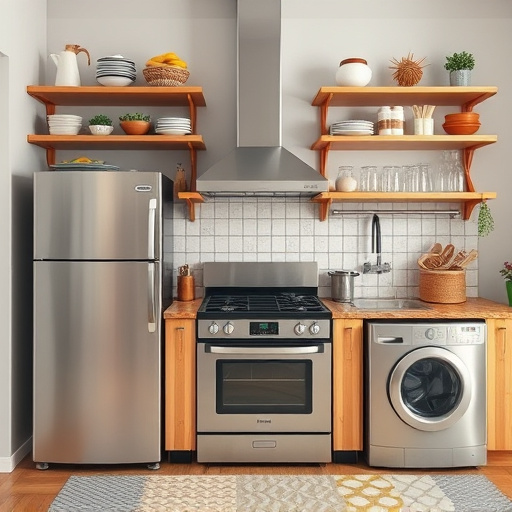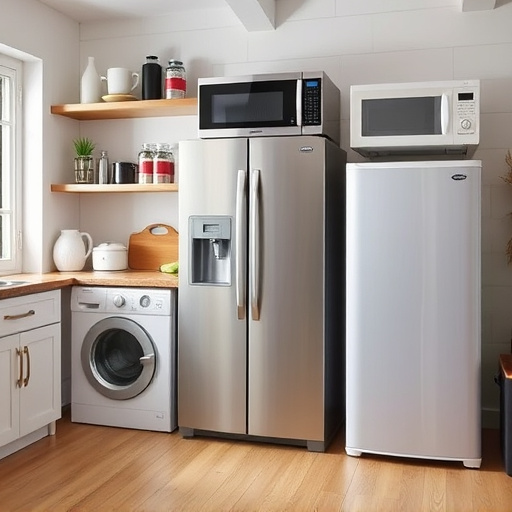Ice maker filters are crucial for maintaining high water quality in major appliances, protecting against contaminants and ensuring clean ice. Over time, they become clogged with debris and chemicals, impacting taste and safety. Regular replacement of high-quality filters is essential for optimal performance, hygiene, and removing harmful substances like lead and mercury. Understanding local water conditions, choosing suitable filter types, adhering to manufacturer guidelines for replacement intervals, and proper maintenance extend filter lifespan and ensure better-tasting water in major appliances.
Ice maker filters are essential components of your kitchen’s water quality system, ensuring the ice you serve is clean and tasty. Regular replacements are key to avoiding common issues like bad taste, odors, and potential health risks associated with old or damaged filters. This article explores the benefits of frequent filter changes, offers guidance on choosing the right ice maker filter for major appliances, provides an installation process for DIYers, and shares maintenance tips to extend filter lifespan.
- Understanding Ice Maker Filters: Their Role in Water Quality
- Common Issues with Old or Damaged Filters
- Benefits of Regular Filter Replacements for Taste and Health
- Choosing the Right Ice Maker Filter: Considerations for Major Appliances
- Installation Process: A Step-by-Step Guide for DIYers
- Maintenance Tips to Maximize Filter Lifespan
Understanding Ice Maker Filters: Their Role in Water Quality

Ice maker filters are an essential component of maintaining high water quality in major appliances like ice makers. These specialized filters serve as the first line of defense against various contaminants, ensuring that the water used for making ice is clean and pure. Over time, these filters collect particles, sediment, and even chemicals, which can negatively impact the taste and safety of the ice. Regular replacement is crucial to preserve the integrity of your ice maker and the quality of the ice it produces.
By understanding the role of these filters, homeowners can make informed decisions about their water purification systems. The process involves selecting the right filter type based on the specific contaminants present in the local water supply and adhering to manufacturer recommendations for replacement intervals. This simple maintenance task not only enhances the taste of ice but also contributes to overall kitchen hygiene, making it a smart step towards maintaining a healthy lifestyle.
Common Issues with Old or Damaged Filters

Old or damaged filters in ice makers can lead to several issues that negatively impact the taste and quality of water. Over time, these filters accumulate debris, minerals, and impurities from the source water, resulting in a buildup of flavor compounds that can make the water unappealing. Additionally, worn-out filters may allow for the passage of contaminants such as bacteria, sediment, and even chemical residues, which not only affect taste but also pose potential health risks.
Major appliances like ice makers rely on clean filters to ensure optimal performance and safe water supply. Regular replacement is crucial to prevent these common issues. By opting for high-quality filter replacements, users can enjoy cleaner, fresher-tasting water from their ice makers, ensuring that every cube is free from impurities and ready for hydration.
Benefits of Regular Filter Replacements for Taste and Health

Regular filter replacements in ice makers are a simple yet powerful way to enhance the taste of your water, ensuring that each cube is as pure and refreshing as possible. Over time, filters can become clogged with minerals, bacteria, and other impurities, leading to a noticeable change in water quality. By replacing these filters at the recommended intervals, users can benefit from improved taste and odor-free water, making their ice cubes a delightful addition to beverages rather than a distraction.
From a health perspective, clean filters are crucial for removing harmful substances like lead, mercury, and other contaminants that may be present in tap water. Major appliances designed with advanced filtration systems play a vital role in maintaining a healthy lifestyle by providing safe, high-quality water for everyday use. This simple maintenance practice is an investment in both the taste and safety of your water, ensuring that every glass or sip from the ice dispenser is enjoyable and free from potential health risks.
Choosing the Right Ice Maker Filter: Considerations for Major Appliances

When it comes to choosing the right ice maker filter for your major appliances, several key considerations come into play. First and foremost, understand your water source. Different filters are designed to target specific contaminants, such as chlorine, lead, or sediment, that might be present in your tap water. Knowing these issues will help guide you towards the most suitable filter option.
Additionally, consider the flow rate and capacity of your ice maker. Filters with higher flow rates ensure a steady supply of clean water for faster and more efficient ice production. Look into the compatibility with your specific major appliance model to guarantee a seamless fit and optimal performance.
Installation Process: A Step-by-Step Guide for DIYers

Installation Process: A Step-by-Step Guide for DIYers
To enhance your major appliances’ performance and ensure a constant supply of clean, great-tasting water, replacing ice maker filters is essential. Here’s a straightforward guide to help you navigate this task. Begin by locating the filter, typically found inside the ice maker compartment. Next, gather the necessary tools: a flathead screwdriver, new filter cartridges (ensure they’re compatible with your model), and clean gloves for safety. Power off and disconnect the appliance before beginning the installation process. Using the screwdriver, carefully remove any screws securing the filter housing. Gently pull out the old filter cartridge and discard it responsibly. Insert the new filter, aligning it precisely as per manufacturer instructions. Once in place, reattach the housing with the screws. Reconnect your ice maker to power and run it for a few minutes to flush out any residual taste from previous filters.
Maintenance Tips to Maximize Filter Lifespan

Regular maintenance is key to extending the lifespan of your ice maker filter and ensuring optimal water taste. One of the simplest ways to care for your filtration system is by cleaning or replacing it as recommended by the manufacturer. Most filters require periodic flushing to remove any accumulated debris or buildup, which can affect water flow and quality.
Additionally, keeping your major appliances well-maintained involves checking the filter for signs of wear or damage. This includes inspecting for cracks, holes, or discolouration, especially if your water supply has high mineral content. Timely replacement is crucial, as a degraded filter not only fails to purify water effectively but can also introduce unpleasant tastes and odours.
Ice maker filters play a pivotal role in maintaining water quality and enhancing the taste of your ice. Regular replacement is key to ensuring these crucial components function optimally, promoting both health and satisfaction with your frozen treats. When considering replacements for major appliances like ice makers, understanding compatibility, performance, and material quality is essential. By following simple installation guidelines and implementing effective maintenance tips, you can extend filter lifespan and enjoy cleaner, tastier water for years to come.
